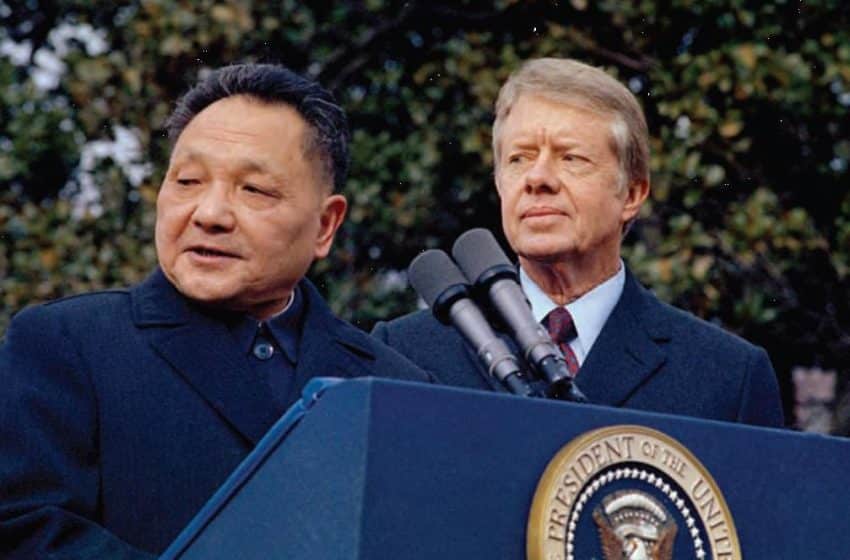Significance and Challenges: U.S.-China Cooperation on the Fentanyl Issue
- Analysis
 Bikai Chen
Bikai Chen  Xuezhou Han
Xuezhou Han- 07/02/2024
- 0
[Editor’s Note: Bikai Chen and Xuezhou Han earned their Master’s degrees in International Relations from the Johns Hopkins University School of Advanced International Studies. Their research interests focus on U.S.-China relations. The views expressed in this article are the authors’ own.]
Fentanyl, a synthetic opioid, holds a grim distinction in the illicit drug market for its heroin-like effects, while being a staggering 50 times more potent than heroin and a hundred times stronger than morphine. The repercussions of its excessive use are devastating, contributing to approximately 100,000 deaths annually in the United States alone. This toll eclipses the peak deaths from potent cocaine abuse in 1988 by more than tenfold. Particularly alarming is the surge in fatalities among individuals aged 18 to 49 attributed to fentanyl abuse, surpassing other public health concerns and precipitating a crisis that has garnered considerable attention from both the U.S. government and society at large.
Indeed, it’s important to clarify that fentanyl itself is a legally used drug, often prescribed by doctors to manage severe pain, with its production and sale authorized by the government. However, the crisis arises predominantly from illegally manufactured fentanyl. The United States government believes that China is the primary source of illicit fentanyl in the country. Without highly effective prevention, treatment, and law enforcement measures against fentanyl abuse domestically, the United States aims to disrupt the illicit fentanyl market’s supply chain as a critical strategy.
In 2017, the Trump administration began heavily emphasizing the connection between the fentanyl crisis and China. In December 2018, after a meeting with President Trump at the G-20 summit, President Xi Jinping pledged that China would regulate all synthetic opioid drugs, including fentanyl. In May 2019, China expanded its regulatory system to encompass the entire category of fentanyl-like substances. This means that all such substances produced or used in China without government authorization are regarded as drugs, and their production, trafficking, and export are subject to drug control laws and regulations. As a result, the direct smuggling of fentanyl from China to the United States has notably decreased.
However, as bilateral relations deteriorated, drug control cooperation between China and the United States sharply declined after 2020. In August 2022, following an escalation in the Taiwan Strait, China officially announced the suspension of all anti-drug cooperation with the United States. Meanwhile, although the production and sale of fentanyl-like substances in China are strictly controlled, some chemical materials that can be used to make fentanyl but also have a wide range of other legitimate uses – so-called fentanyl “precursors” – are not subject to China’s stringent regulatory system. Any company can produce, export, and use these precursors without reporting to government authorities. As a result, some fentanyl precursors make their way to drug smuggling groups in Mexico and elsewhere. These groups synthesize the precursors into illicit fentanyl in drug factories outside the United States, which is then smuggled into the United States for sale.
The United States subsequently announced a series of prosecutions and sanctions against Chinese individuals and companies suspected of involvement in the illegal fentanyl supply chain. Besides the resumption of traditional anti-drug cooperation between the two countries, the United States’ demands also include the inclusion of fentanyl precursors in China’s export controls. However, as commodities with legitimate uses and reasonable demand, subjecting precursors to export control solely because they may be used to produce illicit fentanyl will undoubtedly harm the interests of many Chinese enterprises. Moreover, according to international practice, it is the basic responsibility of the importing enterprises and the legal obligation of the importing country’s government to ensure that internationally traded goods are not used for illegal purposes.
The San Francisco summit on November 15, 2023, between President Xi and President Biden marked a turning point on this issue. Both sides agreed to find ways to limit the transnational movement of fentanyl precursors used as raw materials for the production of illicit fentanyl. They also outlined plans to establish a joint working group to advance these efforts. In a reciprocal gesture, the United States removed the Institution of Forensic Science of the Ministry of Public Security from its trade sanction list, a designation imposed in 2020 for reasons unrelated to anti-drug cooperation. Notably, the National Narcotics Laboratory of China, responsible for drug identification, falls under this institute. This action signified a genuine commitment to collaborating with China on drug control initiatives. Subsequently, on January 30, 2024, the inaugural meeting of the anti-drug cooperation working group between the two nations was convened in Beijing, marking the resumption of cooperation on the fentanyl issue between both sides.
As one of the few areas where cooperation between China and the United States can be sustained, their collaborative efforts in combating illegal fentanyl undoubtedly exert a positive influence on the increasingly strained bilateral relations.
Firstly, such cooperation serves to rebuild mutual trust between Chinese and American officials, a crucial element amid the pervasive atmosphere of competition characterizing Sino-American relations across economic, technological, and military domains. In an environment where suspicion and hostility have eroded mutual trust, combating illegal fentanyl offers a common ground for both nations to pursue shared objectives.
Anti-drug efforts necessitate collaboration across various government departments, demanding extensive information sharing, intelligence exchange, and law enforcement cooperation. A notable example is a case sentenced in November 2019 in which the Chinese Ministry of Public Security’s Narcotics Control Bureau and the U.S. Department of Homeland Security’s Immigration and Customs Enforcement collaborated, sharing intelligence and evidence. This joint effort led to the dismantling of a criminal network engaged in the illegal processing, trafficking, and smuggling of fentanyl and other narcotics. The recent Sino-American anti-drug cooperation working group meeting further underscored the commitment of both sides, with senior officials from key U.S. government departments—such as the State Department, Treasury Department, Department of Homeland Security, and Department of Justice—engaging alongside counterparts from China, including a State Councilor and Minister of Public Security.
Through sustained cooperation, both nations gain valuable insights into each other’s perspectives, capabilities, and operational approaches, fostering a gradual restoration of trust. This process may also serve as a catalyst for improving relations in other areas. Moreover, by compartmentalizing diplomatic differences concerning fentanyl issues and prioritizing functional cooperation, the regular meetings of the anti-drug cooperation working group can serve as a stable channel for communication between China and the United States. This channel proves invaluable during times of significant fluctuations in bilateral relations, providing an avenue for urgent communication and collaboration beyond anti-drug initiatives.
Secondly, cooperation between China and the United States on the fentanyl issue holds the potential to reshape the perceptions of each nation among their respective populations. While American politicians often leverage the fentanyl issue to advance their political agendas, it’s undeniable that negative portrayals of China in relation to fentanyl resonate deeply with Americans affected by the scourge of fentanyl abuse. Conversely, in China, growing U.S. pressure in economic and technological spheres, coupled with tensions over issues like Taiwan and the South China Sea, has generated nationalist sentiments against the United States.
The escalating animosity between the citizens of the world’s two largest economies sends a perilous signal. In such a climate, any collaborative effort fostering a positive atmosphere is profoundly meaningful. By demonstrating a shared commitment, both China and the United States can mitigate the negative perceptions that have strained their relationship. This shift in public opinion can foster greater understanding, empathy, and ultimately, trust between the peoples of both nations. By enhancing each other’s image in the eyes of their respective populations, cooperation on the fentanyl crisis can pave the way for broader and deeper people-to-people exchanges. These exchanges, in turn, contribute to a more stable foundation for Sino-American relations.
While acknowledging the positive impacts, it’s important to recognize that cooperation between China and the United States on the fentanyl issue is intricately linked to shifts in bilateral relations. There isn’t a direct shared interest between the two nations regarding fentanyl; Chinese society doesn’t have a problem with fentanyl abuse, and the crisis predominantly affects American society. From China’s standpoint, collaborating with the United States to combat illegal fentanyl can be seen as assisting the U.S. in addressing its domestic social challenges, which aligns with U.S. national interests. Consequently, China also expects reciprocity from the United States in other domains, perhaps even leveraging this cooperation to steer strategic relations between the two countries back toward cooperation. The absence of shared interests inevitably positions cooperation on the fentanyl issue as a bargaining chip. If the United States attempts to compete with China in strategic arenas such as the economy, security, and technology, and exert pressure on China regarding issues like Taiwan and the South China Sea, while simultaneously expecting cooperation in areas where it desires collaboration, such an approach is probably unrealistic.
As the U.S. political arena has hardened its attitude toward China, criticizing China has gradually become the mainstay of politicians’ narratives on the fentanyl issue. Fewer and fewer people are discussing the fentanyl crisis from a public health perspective, and many are keen to politicize it and elevate it to the level of overall China policy. In this way, the fentanyl issue may become a tool to demonstrate being tough on China and create political capital. It will be difficult to address the issue in an objective and rational manner in such an environment.
In conclusion, the complex dynamics surrounding cooperation on the fentanyl crisis underscore the broader complexities characterizing Sino-American relations. Any attempt to navigate these complexities must be rooted in a nuanced understanding of each other’s perspectives, interests, and sensitivities, while striving for mutually beneficial outcomes.







